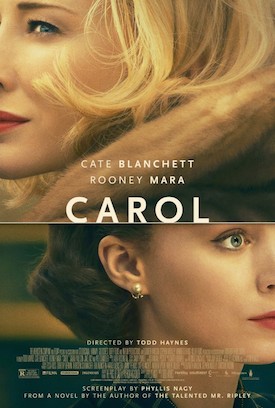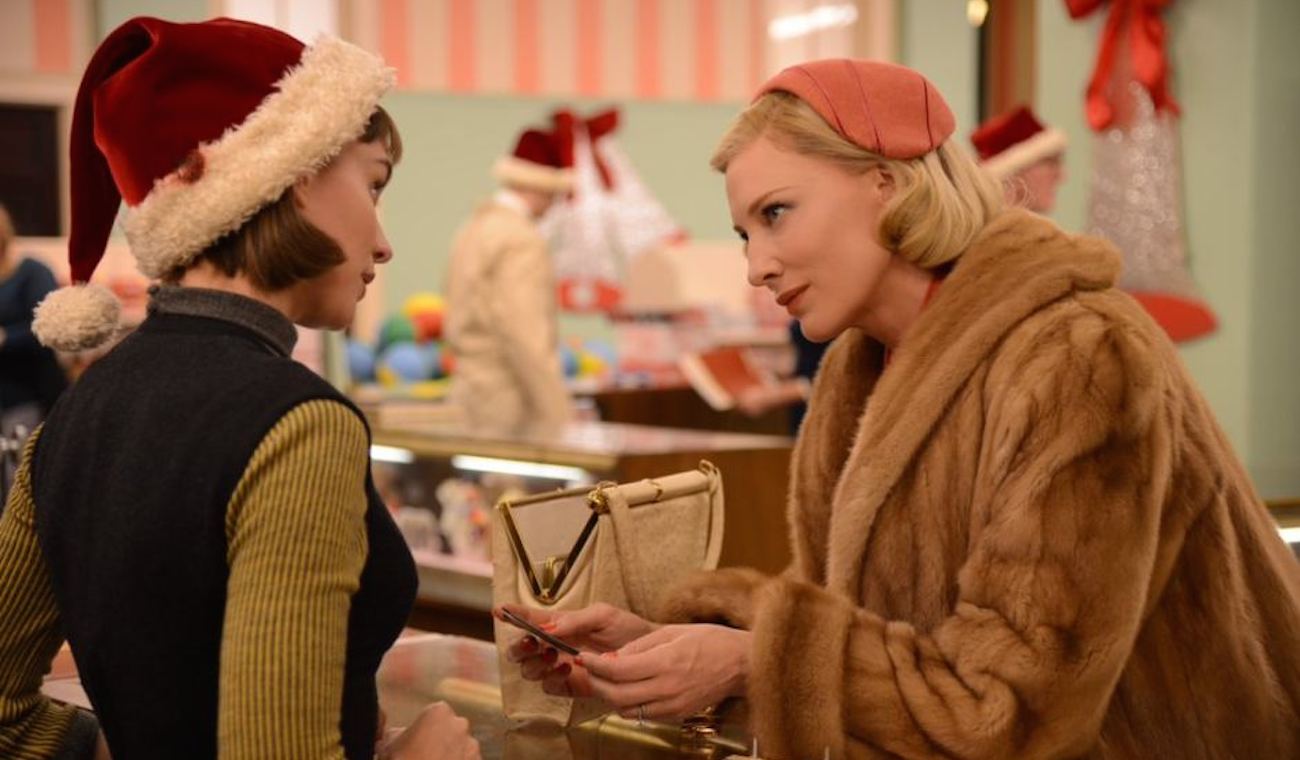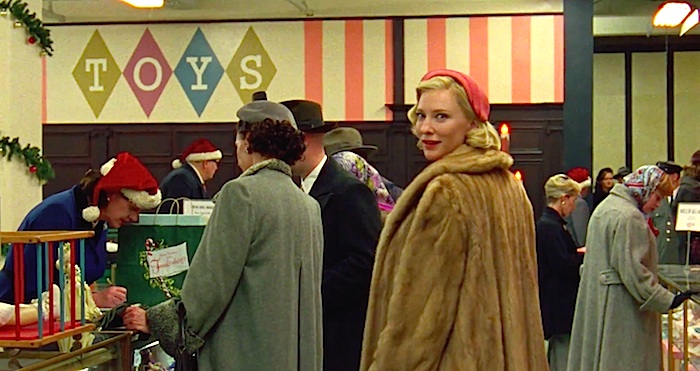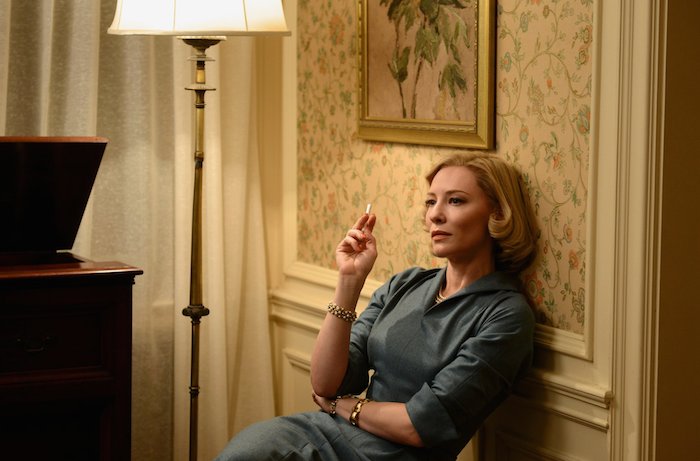 I think being the production designer would be one of the coolest jobs in Hollywood, especially on a period film. Judy Becker has designed many gorgeous films from different periods including American Hustle (for which she received an Oscar nomination), Hitchcock, Silver Linings Playbook, The Fighter, and Brokeback Mountain. She currently has two films out, David O. Russell’s Joy starring Jennifer Lawrence and Robert De Niro and Todd Haynes’ Carol with Cate Blanchett and Rooney Mara. An adaptation of Patricia Highsmith’s novel The Price of Salt, the 1950s-based Carol follows two women from very different backgrounds who find themselves in an unexpected love affair. A young woman in her 20s, Therese Belivet (Mara), is a clerk working in a Manhattan department store and dreaming of a more fulfilling life when she meets Carol (Blanchett), an alluring woman trapped in a loveless but convenient marriage. Their immediate chemistry eventually turns into a much deeper connection, but the conventions of the time creates serious problems for the women. With a screenplay by Phyllis Nagy, Carol also stars Kyle Chandler, Sarah Paulson, and Jake Lacy. I sat down with Judy Becker to discuss how she recreated 1950s New York for this film.
I think being the production designer would be one of the coolest jobs in Hollywood, especially on a period film. Judy Becker has designed many gorgeous films from different periods including American Hustle (for which she received an Oscar nomination), Hitchcock, Silver Linings Playbook, The Fighter, and Brokeback Mountain. She currently has two films out, David O. Russell’s Joy starring Jennifer Lawrence and Robert De Niro and Todd Haynes’ Carol with Cate Blanchett and Rooney Mara. An adaptation of Patricia Highsmith’s novel The Price of Salt, the 1950s-based Carol follows two women from very different backgrounds who find themselves in an unexpected love affair. A young woman in her 20s, Therese Belivet (Mara), is a clerk working in a Manhattan department store and dreaming of a more fulfilling life when she meets Carol (Blanchett), an alluring woman trapped in a loveless but convenient marriage. Their immediate chemistry eventually turns into a much deeper connection, but the conventions of the time creates serious problems for the women. With a screenplay by Phyllis Nagy, Carol also stars Kyle Chandler, Sarah Paulson, and Jake Lacy. I sat down with Judy Becker to discuss how she recreated 1950s New York for this film.
Danny Miller: I would a imagine a film set in this time period is a very plum assignment for a production designer.
Judy Becker: Yes, absolutely! I think every designer loves working on period movies, it’s so much fun. I love doing the research and figuring out how to convey the period in a very believable manner without resorting to clichés.
I interviewed you for Hitchcock a few years ago and I remember you telling me about recreating very well known spots that no longer exist, like when you turned the restaurant Musso & Frank’s into Chasen’s.
Yeah, that was kind of amazing. We added wood paneling to all the walls. Musso & Frank’s is only closed on Sundays and Mondays so we prepped Sunday night, shot on Monday, and were out of there by Monday night!
For this one, did you have to recreate any real locations like that?
The book and the movie were set in New York City and I’ve lived there my whole life which was helpful in designing this movie because that city has changed so much in the past 10 years. Everything was fictionalized in the book but in real life, author Patricia Highsmith had worked at Bloomingdale’s and had hated it so our Frankenberg’s is essentially Bloomingdale’s!
That must have been great fun to create a 1950s department store. Was that done on a soundstage?
No, it took a long time to find in Cincinnati where the film was shot but we wanted a real building from that time period that gave us the vintage walls and ceiling and floor. But then we created everything inside the store. We ended up being very influenced by this fabulous short film from 1956 called Lovers and Lollipops that was directed by Morris Engel and Ruth Orkin who were both photographers. It was shot completely documentary-style and in the film this single mother and her child go to the toy department at Macy’s. It was such a revelation because everything looked a bit junky and everything was kind of mushed together. That really influenced us a lot in terms of how we placed our toys. We had the really nice dolls in a glass case but then there were also a lot of lower-level dolls in the department.
Did you recreate all of those items or find actual vintage toys?
Both. We found vintage dolls that we restored to make them look new and found newer dolls that we made look vintage. We ended up designing and fabricating around 30 different toy boxes, you just can’t find any pristine vintage ones. They were fantastic! My set decorator, Heather Loeffler, found this great box manufacturer in Cincinnati who made them for us.
I remember when we talked about Hitchcock, you mentioned a scene that had been cut that broke your heart because you loved the set so much. Were there any examples of that here?
Oh God, the mural. I have to watch the extras on the DVD to see if that scene is there! On this film, almost everything that we did was used. But actually, there was a scene in which Therese drops a bunch of those boxes I just mentioned that was cut but you can still see them scattered about. I would have been devastated if our toy department had been cut!
Was Carol’s gorgeous house shot in a real house?
Yes, that was an amazing mansion we found outside Cincinnati, you should see the huge mansions they have there! It was a very beautiful house that, for the most part, was quite intact for the period. We only had to do some painting and some work in the kitchen since those are always updated. We brought in new furniture that matched the characters but I loved all of the actual details of that house, it was gorgeous.
Do you prefer using real locations over a soundstage?
It really depends on the movie, I like both. There are certain types of sets that lend themselves better to locations. For example, I think that it’s very hard to make a domestic interior look real on a soundstage. It’s a lot of work to make an interior look lived-in and real and you can usually tell. But other kinds of sets lend themselves to being done on a soundstage like a motel room or anything that’s kind of an enclosed space. Sometimes it can go either way. On American Hustle, we built some huge sets like the Plaza Hotel and Amy Adams’ apartment and those were great to have on a soundstage because we could be very specific and create exactly what we needed for the blocking. If you’re going to be in a place for just a day or two, it usually doesn’t play to built it from scratch unless it’s a very small set. Like we built the projection booth for this film because a real one is too hard to shoot in.
What about Therese’s apartment?
That was a real apartment that we found early on in the scouting process. I had a gut feeling that this was the right place and we used both the exterior and the interior. It was a great old building and the landlord said that we could cut archways in the walls which let the camera move around for all of the action which was very helpful. And again, we took everything out of the kitchen and created a period one which was very fun because I modeled it after some of the tenement apartments I had worked on as a set dresser, the ones that had the bathtub in the kitchen. I love the scene when Therese wakes up and she’s freezing so she lights the oven to get some heat and then she brushes her teeth in the kitchen sink because those apartments didn’t have regular bathrooms. To me that portrays the period more than anything could.
Did you use any films of the period, like Douglas Sirk films, as a kind of inspiration?
No, not at all. In fact, it was a very deliberate choice on Todd’s part not to evoke those movies here since his movie Far from Heaven was a film that was almost about films of that era. It was interesting because I loved Far from Heaven but when I saw it I wondered what it would be like if you took that subject matter and protrayed it in a very naturalistic manner which is essentially what Carol is. They are very different films. I think Todd is such a genius as a filmmaker in terms of how he approaches material and how he knows instinctively exactly the right way to approach it.
He definitely seems like someone who has a very specific vision. Does that translate into him having a lot of input in the production design?
Definitely, there’s always a lot of collaboration with him. He comes to the project right away with a very clear idea of what he wants the movie to look like and he already has a reference book full of images and specific artists and photographers he wants to reference. For me that’s a great thing, I love working with him. It would be kind of boring to do a movie where the director didn’t want to be that involved. It might feel like freedom but it wouldn’t really be freedom.
Not that you want a David O. Selznick-like control freak who says, “I hate the wallpaper, take it all off!”
Yeah, the worst is when there’s someone who’s not really involved with the film but has some connection to the director and comes to the set with a lot of opinions.
Oh, God. Like the director’s girlfriend who doesn’t like a certain color palette and tells him to make you change it?
Oh, it happens. (Laughs.) Now that would be a total nightmare!
Are there any time periods that you’re still itching to get your hands on?
I’ve never done a late 1960s movie. I’d love to do one of those my way — not too over the top. I’d also love to do a Depression-era movie with a kind of Walker Evans kind of aesthetic, I think that would be great. And I’m not done with the 70s, I’ve done one version of it but there’s so much more I’d like to explore.



